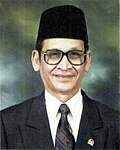
Back Pemilihan umum legislatif Indonesia 1992 ID Indonesische parlementsverkiezingen 1992 Dutch Wybory parlamentarne w Indonezji w 1992 roku Polish 1992年印度尼西亞立法選舉 Chinese 第6屆印尼立法機構選舉 ZH-YUE
| |||||||||||||||||||||||||||||||||||||||||
400 of the 500 seats in the House of Representatives[a] 201 seats needed for a majority | |||||||||||||||||||||||||||||||||||||||||
|---|---|---|---|---|---|---|---|---|---|---|---|---|---|---|---|---|---|---|---|---|---|---|---|---|---|---|---|---|---|---|---|---|---|---|---|---|---|---|---|---|---|
| |||||||||||||||||||||||||||||||||||||||||
 Results by city and regency Golkar PPP | |||||||||||||||||||||||||||||||||||||||||
| |||||||||||||||||||||||||||||||||||||||||
Legislative elections were held in Indonesia on 9 June 1992, to select 400 of the 500 members of the People's Representative Council (DPR).[a] The election was the sixth legislative elections since Indonesian independence and the fifth legislative elections under the New Order regime of president Suharto. The election resulted in a clear victory for Golkar, which retained its status as the ruling party, although the opposition, under the United Development Party (PPP) and the Indonesian Democratic Party (PDI), saw their vote shares rise.
Golkar had governed Indonesia since 1971, winning four consecutive elections. However, by the late 1980s, it had struggled with internal division, between the military wing and the civil and bureaucratic wing, as well as demands for more openness in government. The opposition, led mainly by the Islamic PPP and the nationalistic PDI began to take advantage of public dissatisfaction with Golkar, though were careful in portraying themselves as not an opposition force.
The election campaign began on 10 May and ended on 3 June, with a six-day election silence up until election day on 9 June. Golkar ran a campaign based on stability and economic progress, with a priority in fighting corruption and re-electing Suharto to a fifth term. The PPP's campaign was centered on building a pro-people economy and bringing about social justice, while the PDI's was based on imposing term limits on the president, tougher sentences for corruption and an end to monopolies.
The polls closed on election day, but the results were only released on 29 June. Golkar, like in all other elections during the New Order, won an outright majority. Defeating the PPP and the PDI, by more than 50 millions votes. However, the opposition managed to make gains, gaining 5% of the vote and 17 seats from Golkar. The election was the first ever election to be covered by private television channels, since Indonesia began the broadcast of private television stations in 1989, with a joint partnership between the private RCTI and SCTV channels, airing along the government-owned TVRI's national coverage.
Cite error: There are <ref group=lower-alpha> tags or {{efn}} templates on this page, but the references will not show without a {{reflist|group=lower-alpha}} template or {{notelist}} template (see the help page).


